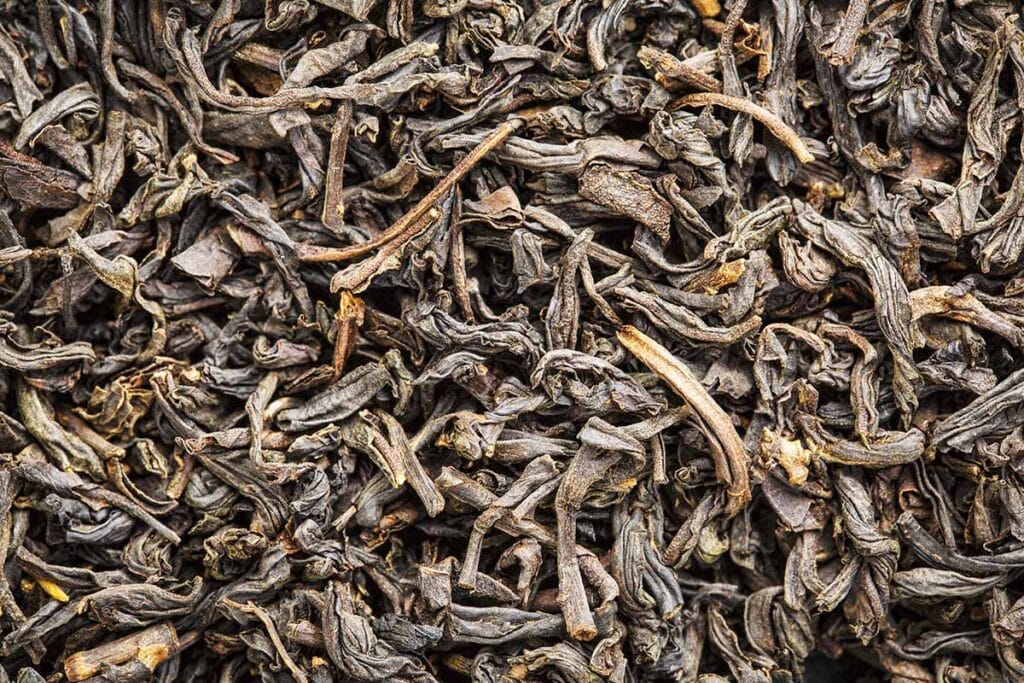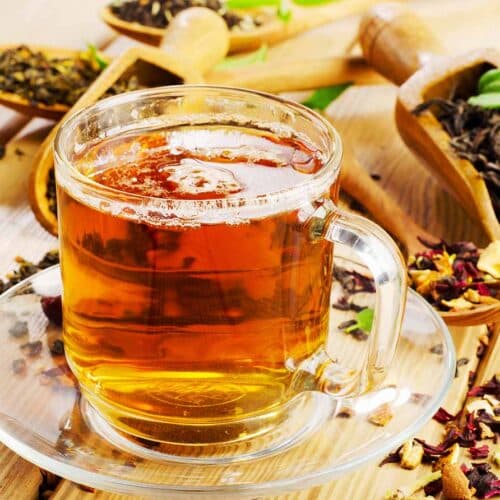Black tea is known for its distinct color, flavor, and aroma. For those who haven’t tried it, you’re probably wondering, “What does black tea taste like?”
This article will answer that and more, including a brief rundown on the different types of black tea, their flavor notes, the perfect food pairings, and tips to prepare and store it.

Black tea is the most common type of tea made from the leaves and leaf buds of the Camellia sinensis plant.
Other types of tea, including white, green, pu-erh, and oolong tea, also come from this tea plant.
But what makes black tea different is its oxidation process.
Unlike green tea, which has low oxidation, black tea leaves are fully oxidized under controlled humidity and temperature (oolong and white tea have partial oxidation).
This slightly longer oxidation process gives it its distinct color and taste.
The oxidation process turns tea leaves from green to brown to black.
Some popular blends of black tea include Masala Chai, Earl Grey, and English Breakfast.
Black tea is definitely a good pick-me-up for slow and lazy mornings because of its high caffeine content (it has the most caffeine in teas).
An 8-oz cup of black tea has around 47 mg of caffeine, while the same serving of coffee has approximately 95 mg.
Like green and white teas, it’s also packed with nutrients and health benefits.
When you brew black tea, it results in a rich dark brown or coppery color and stronger, more robust flavors.

Black tea tastes like light beer minus the acidity and the alcohol.
Other tea drinkers say it tastes dark, malty, bold, smoky, or earthy.
Compared to green tea, which tastes fresh or grassy, black tea tastes more nutty, less bitter, and has a deep aroma.
Some black teas can also develop a spicy, floral, or fruity tone.
If you prepare black tea incorrectly, you’ll end up with something that tastes like paper or vase water!
If you can’t enjoy black tea alone, adding sugar and cream will make it taste better.
While there’s a lot of variety in black tea, in general, these teas often share similar characteristics when it comes to taste.
Different black tea varieties share the same characteristics when it comes to taste.
Here are some of their flavor notes.
Aside from its flavor notes, other ingredients give flavor to black teas.
For example, Earl Grey teas have added flavors of oil of bergamot.
Masala Chai, on the other hand, has Indian spice blends that contain cinnamon, cloves, and ginger.
Ready to start your black tea journey? Here are some of the most popular black tea types and blends.
This bold black tea grows in the Assam region of India.
Assam black tea possesses bold and fragrant properties that don’t overpower.
Don’t write it off just yet when you first taste its tannic and astringent qualities because it gets better after.
Its creamy chocolate and roasted malt aftertaste will surprise you.
Ceylon tea, also known as Sri Lankan tea, is another popular black tea.
Many people like Ceylon because you can enjoy it as warm or iced tea.
While Ceylon black tea is known for its bold, citrusy flavors, its taste also varies significantly, depending on the type of tea and where it’s grown.
This type of black tea is grown exclusively in the Darjeeling district in West Bengal, India.
Darjeeling tea is also known as the Champagne of Tea because of its strong muscatel flavor.
This black tea blend combines well with vanilla for a natural citrusy sweetness.
Other variations, such as the French Earl Grey tea, have cornflowers, calendula, hibiscus, and rose petals, while the Russian Earl Grey tea contains aromatic lemongrass.
According to tea historians, Lapsang Souchong is the earliest black tea.
It’s also known as smoked tea and is grown in the Wuyi Mountains in China.
This ancient tea is made by drying its leaves over smoky pine fires.
Lapsang Souchong is perfect for tea drinkers who like their tea brimming with rich and smoky notes.
Kenya is one of the largest producers of tea in the world.
You’ll enjoy Kenyan black tea if you like solid and full-bodied flavors with hints of chocolate, cardamom, anise, and citrus.
It’s one of the best breakfast teas with or without milk.
This Chinese black tea known for its rich and smooth body.
It’s floral and malty. Sometimes, it also has a flavor profile close to burgundy wine.
Keemun tea is a sweeter, lighter tea, and less overpowering than other teas.
You can instantly tell you’re brewing Keemun tea because its aroma will fill the room.
If you love European-style breakfasts of sausages, eggs, and the works, enjoy them with these black tea blends.
They’re typically a combination of Ceylon, Darjeeling, Assam, and Kenyan black teas. So expect a clean, light, and sweet taste.
The way you brew your black tea will make or break it.
Like all teas, its leaves are very sensitive, so take care not to scald them.
However, black tea is the most processed tea so it can withstand higher temperatures.
You can steep your black tea at 90°C for three to five minutes, after which you’ll see the leaves changing color and the aroma growing stronger.
Always check specific instructions on the package to ensure you brew the perfect cup.
It may have different brewing temperatures and steeping times than you’re accustomed to.

Here are some general instructions on how to prepare black tea for the best results.
Do you prefer your black tea in tea bags or sachets? Here’s the best way to prepare them to maximize the flavor.
Loose-leaf black tea may look intimidating to prepare, but it’s pretty easy.
Compared to teabags, loose-leaf teas give more flavor.
Follow these steps for the perfect brewed black tea.
Note: If you want to save the rest of your black tea for later, don’t allow the tea leaves to steep in the pot. Instead, strain the leaves in the pot and remove the strainer after five minutes.
Pro tip: If it’s your first time tasting black tea (or any tea), try it without adding anything else. Afterward, you can explore flavors when you add ingredients like sugar, milk, or honey.
To enjoy the rich flavor of black tea, pair it with food that best complement or draw out its flavor.
In general, black tea goes well with biscuits and scones.
The robust flavors of black tea also go well with rich and hearty dishes like roast beef, venison, and lamb.
Black tea goes great with heavy meat pasta dishes, so go ahead and enjoy it with lasagna!
Do you love spicy food? Black tea is like milk in cooling your mouth when eating spicy food.
Moreover, black tea makes a great breakfast tea because of its high caffeine content, so pair it with your favorite hearty breakfast, like eggs, sausages, hash, beans, and more.
Want to learn a creative pairing hack? Mix a teaspoon of jam into your black tea. Pick a jam that goes well with your black tea, like raspberry or cherry jam.
Here are more examples of black tea food pairings you should try ASAP:
The base for chai tea is a strong black tea, milk, sugar, and water.
You can make it iced or hot, depending on your liking.
Add traditional Indian spices like star anise, cloves, or cardamom.
Do you love spicy chai latte? Get it with cinnamon buns―you won’t regret it.
You can also pair it with chocolate, custard, and your favorite baked goods.
If you’re going for a fruity black tea, take it with sweet pastries and desserts or anything with a thick aftertaste. A fruity black tea holds the sweetness in your mouth.
If you prefer your black tea with an earthy or malty flavor, serve it with red meat or any meat with a strong flavor, like jerk chicken.
You can also pair it with blackened vegetables or meats and mashed potatoes.
Earthy and malty teas are not naturally sweet, so you can serve them with rich, dense, and not sweet foods.
This black tea has a strong taste and goes perfectly with flavorful or blackened meats.
It goes well with anything you can make on a grill: barbeque, red meat, bacon, and eggs.
You can even pair it with chocolate if you want something light.
The strong flavor of Assam tea goes perfectly with a hearty Continental breakfast.
It also complements red meat, eggs, cheese, chocolate, and carrot cake.
Moreover, you can have it with mangoes, strawberries, pears, peaches, and apricots.
It’s a light and refined black tea that tastes refreshing and mellow.
Have it with an English or Continental breakfast.
Pair it with spicy food or chicken, ham, lamb, and beef.
This quintessentially British tea is smooth and aromatic.
Earl Grey’s citrusy taste perfectly matches lemon cakes, biscuits, and chocolate.
You can also take it with dairy, eggs, baked goods, and spices.
The first flush (harvested in early spring from the very first buds and leaves of the tea plant) produces light, fresh, and airy tea, giving a delicate taste of leaves and spring.
Pair this refreshing tea with grilled fish, fresh fruits, curries, soft cheeses, eggs, and custards.
Meanwhile, the second flush tea is richer, more full-bodied, and gives fruity and muscatel flavors.
Some popular pairings include wild mushrooms, soft cheeses, fruits, and nutmeg.
What type of black tea you choose depends on your preference.
Fortunately, many options suit your tastes or go well with the food you’re serving.
Here are some easy tips to keep in mind.
Black tea won’t spoil if you store it correctly. However, it can get stale and lose its freshness after a while.
Store your black tea in a cool and dry place away from sunlight, strong odors, or moisture to keep it fresh and flavorful. It can last up to two years.
You can store it in an airtight, non-plastic container or resealable bag.
It will help protect your tea from oxidation and humidity, which can affect the tea’s taste and aroma.
If using a glass container, make sure it’s dark-colored or opaque so that sunlight won’t affect the tea quality.
Moreover, don’t store your tea leaves inside the refrigerator or freezer. The food odors will spoil your tea’s flavor.
Don’t store it beside spices and coffee, too, because it can leach their flavors into the tea leaves.
Buy fresh tea in small quantities. Label your container with the date you bought it to know how long it’s been in storage.
Yes. Black tea has a full-bodied flavor with malty, earthy, smoky, sweet, and fruity notes. They taste different from green tea, which usually has grassy, nutty, and vegetal notes, or white tea with fruity, floral, and sweet notes.
No. Even if black tea has a lot of bitter compounds, your tea will only get bitter if you use too many black tea leaves or brew them for too long at very high temperatures. So, get your water to the right temperature before pouring it on your teabag or tea leaves.
It can be an acquired taste for some people. Black tea has a strong and bitter flavor, especially when taken without milk or poorly or incorrectly prepared. But when done right, black teas offer some of the most delicate and complex flavors you’ll keep coming back to!
People worldwide enjoy black tea because it’s a delicious and versatile beverage. The tea leaf type and quality, plus your brewing method, will change how your black teas taste. So, it’s best to learn the correct way to prepare it so you can fully enjoy its robust flavors.
Whether you like a smooth Earl Grey, a bold tea like Ceylon, or a smoky Lapsang Souchong, savor the tea preparation process and enjoy every sip. Black tea is great with sweet flavors, so make sure to have sweet cakes, fruits, or biscuits to pair it with for your afternoon tea.






